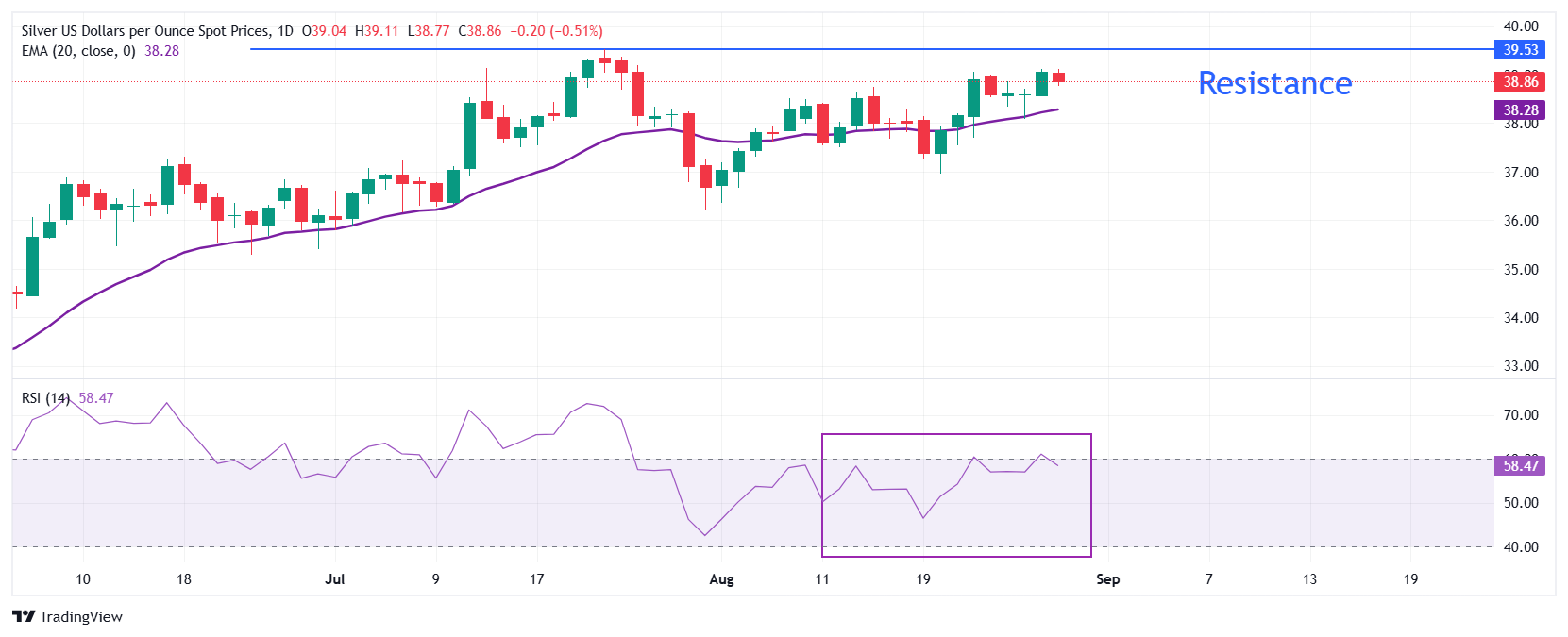Silver Price Forecast: XAG/USD corrects slightly from $39 ahead of US PCE inflation data
- Silver price retreats to near $38.80 ahead of the US PCE inflation data for July.
- Fed’s Waller warns of labor market risks and supports interest rate cuts in September.
- Silver price holds above the 20-day EMA, which is around $38.28.
Silver price (XAG/USD) trades 0.6% lower around $38.80 during the European trading session on Friday. The white metal corrects slightly after failing to extend its upside above $39.00, with investors awaiting the United States (US) Personal Consumption Expenditure Price Index (PCE) data for July, which will be published at 12:30 GMT.
Economists expect the US core PCE inflation, which is the Federal Reserve’s (Fed) preferred inflation gauge, to have risen at a faster pace of 2.9% on year against 2.8% in June, with the monthly figure rising steadily by 0.3%.
Technically, signs of price pressures accelerating force traders to pare bets supporting interest rate cuts by the Federal Reserve (Fed). However, the impact is expected to be limited as Fed officials have lately expressed more concerns about deteriorating labor market conditions than rising inflation.
Lower interest rates by the Fed bode well for non-yielding assets, such as Silver.
On Thursday, Fed Governor Christopher Waller cited that he will support lowering policy rates by 25 basis points (bps) in September as downside labor market risks have increased.
Ahead of the US PCE inflation data, the US Dollar (USD) trades almost stable. The US Dollar Index (DXY), which tracks the Greenback’s value against six major currencies, trades calmly around 98.00.
Silver technical analysis
Silver price trades slightly lower around $38.80 on Friday. The near-term trend of the white metal remains bullish as it holds above the 20-day Exponential Moving Average (EMA), which trades around $38.28.
The 14-day Relative Strength Index (RSI) struggles to break above 60.00. A fresh bullish momentum would trigger if the RSI breaks above that level.
Looking down, the June 24 low of $35.28 will act as key support for the major. On the upside, the July 23 high near $39.53 will be a critical hurdle for the pair.
Silver daily chart

Silver FAQs
Silver is a precious metal highly traded among investors. It has been historically used as a store of value and a medium of exchange. Although less popular than Gold, traders may turn to Silver to diversify their investment portfolio, for its intrinsic value or as a potential hedge during high-inflation periods. Investors can buy physical Silver, in coins or in bars, or trade it through vehicles such as Exchange Traded Funds, which track its price on international markets.
Silver prices can move due to a wide range of factors. Geopolitical instability or fears of a deep recession can make Silver price escalate due to its safe-haven status, although to a lesser extent than Gold's. As a yieldless asset, Silver tends to rise with lower interest rates. Its moves also depend on how the US Dollar (USD) behaves as the asset is priced in dollars (XAG/USD). A strong Dollar tends to keep the price of Silver at bay, whereas a weaker Dollar is likely to propel prices up. Other factors such as investment demand, mining supply – Silver is much more abundant than Gold – and recycling rates can also affect prices.
Silver is widely used in industry, particularly in sectors such as electronics or solar energy, as it has one of the highest electric conductivity of all metals – more than Copper and Gold. A surge in demand can increase prices, while a decline tends to lower them. Dynamics in the US, Chinese and Indian economies can also contribute to price swings: for the US and particularly China, their big industrial sectors use Silver in various processes; in India, consumers’ demand for the precious metal for jewellery also plays a key role in setting prices.
Silver prices tend to follow Gold's moves. When Gold prices rise, Silver typically follows suit, as their status as safe-haven assets is similar. The Gold/Silver ratio, which shows the number of ounces of Silver needed to equal the value of one ounce of Gold, may help to determine the relative valuation between both metals. Some investors may consider a high ratio as an indicator that Silver is undervalued, or Gold is overvalued. On the contrary, a low ratio might suggest that Gold is undervalued relative to Silver.


